Spending extended one-on-one time with a work of art can be a delight. It offers the art lover a rare chance to inspect the work closely, get to know its details, and feel its energy and warmth.
This is the experience Park Hotel Tokyo offers its guests. Each of the thirty-one rooms on its thirty-first floor features a unique art space—thirty-one masterful, immersive exhibits presented in custom-painted rooms where customers can spend a night or more.
A Park Hotel guest can occupy a beautiful, well-appointed hotel room where they are surrounded with amazing artworks by modern Japanese artists.
Inspired by the beauty and aesthetics of Japan, each room is as different as thirty-one paintings in an art museum. A Park Hotel guest can occupy a beautiful, well-appointed hotel room where they are surrounded with amazing artworks by modern Japanese artists.
The hotel started this project in December 2012, and the last room was completed in July 2017. Three of us, Mami, Viet, and Koichi, visited Park Hotel Tokyo in the spring of 2016, when we got a sneak peek of some of the rooms and the chance to chat with a few of the artists. We fell in love with this beautiful hotel and the art that lives inside. Here is our story.
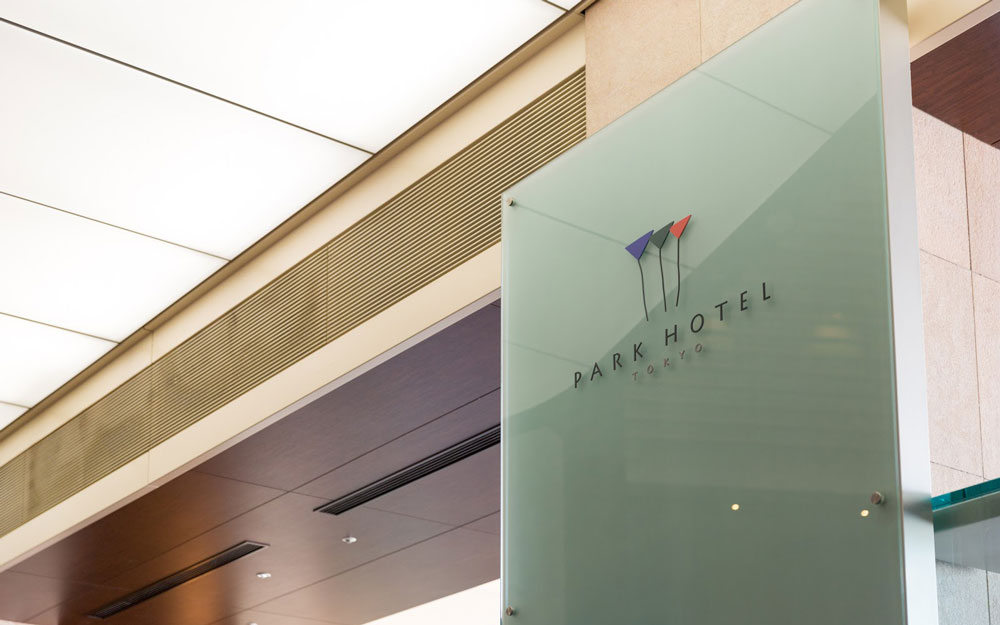
Although our appointment at the hotel was at 9:00 a.m., we may have been still recuperating a bit from the wild time we had the night before at Kagaya, because we ran into a little trouble at the start. We had set our alarm, gotten up on time, and even arrived at Shimbashi Station right on schedule… and then we went to the wrong hotel!
We were definitely sober. It's just that there's a similarly named hotel—the Royal Park Hotel—right near Park Hotel Tokyo. Thus were we unfortunately late for our appointment. Travelers, beware!
Located inside the Shiodome Media Tower, Park Hotel Tokyo begins on the twenty-fifth floor and rises for ten more. In the elevator, we watched as the city grew smaller and smaller below us. Ding! When the door opened, we soon found Matsubara Yuko, the marketing and PR person in charge, and apologized profusely for being late.

"Did you happen to go to another Park Hotel?" she asked with a smile. "That's actually a common mistake many people make." Luckily for us, she didn't seem upset. She welcomed us and got started with our tour, turning our attention to the amazing building.

The hotel's first and most obvious descriptions were bright and spacious. Sunlight poured through the massive skylight, which seemed to hang in the air a mile above. Matsubara saw us looking up. "This is our signature ten-floor-high atrium," she said, smiling again. "It stretches from the thirty-fourth floor down to the twenty-fifth. The ceiling is made of glass, so the natural sunlight floods in."
Impressed as we were by the skylight, Matsubara also pointed out the big windows around us, and we found ourselves amazed by the hotel's eye-popping view of the city, with Tokyo Tower and Mt. Fuji in the distance. Matsubara said that we were lucky: on cloudy or rainy days, the famous mountain can't be seen—on this day, however, its view was astonishingly clear.
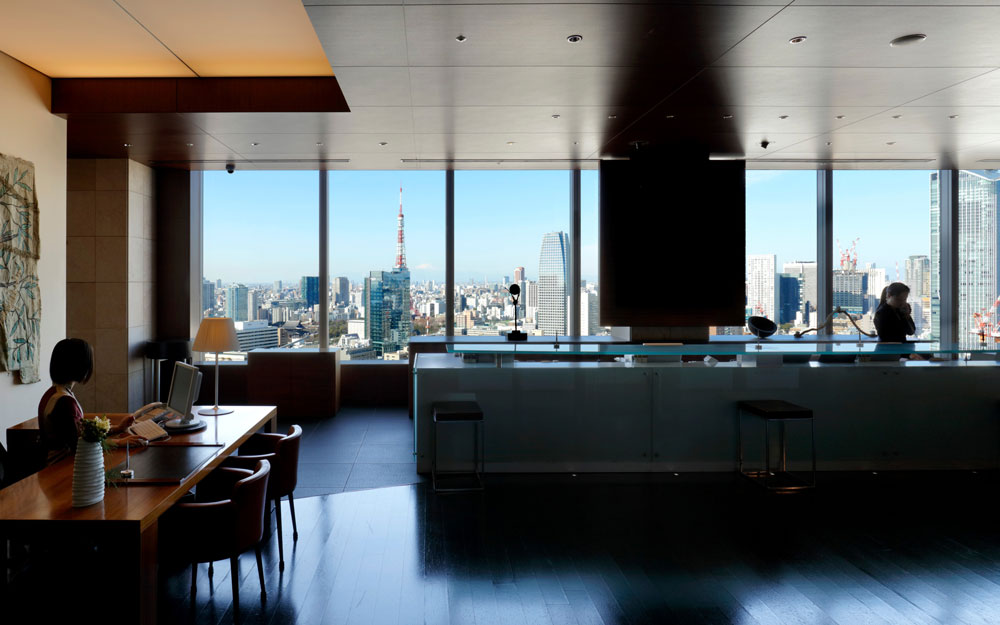
After chatting in the lobby for a bit, we took the elevator up to the 31st floor to see the artist rooms. On our way, Matsubara apologized that not all of them were available to show to us that day—many of the completed rooms, she explained, were occupied by paying guests. She would be showing us five:
She explained that many of the artist rooms are booked in advance, and usually guests don't know which room they'll be staying in until they arrive. "When you check in is when you can choose from the available rooms that day," she said.
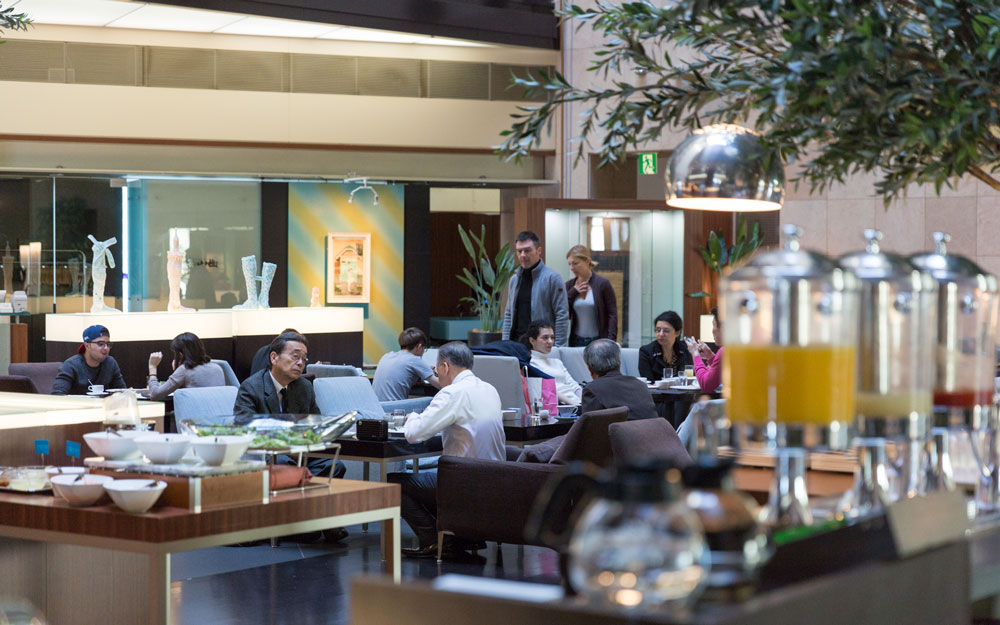
Mami was curious about international visitors. "If somebody wants to book specific room, can they do it in English?" she asked.
Matsubara gave a quick, affirmative bow. "Yes, all our staff can speak English," she said. "Although their abilities vary, at the very least we all know basic conversational English." She explained that 80% of the hotel's clients are non-Japanese, and certain members of the staff can speak German, Korean, and French. (As any international traveler knows, being able to speak one's own language can really take a load off!)
"While many tourists who come to Japan are Chinese, the majority of our guests are American or European," she added. "Our Japanese clients who don't know that are often surprised to see so many foreign customers here."
We had arrived at the thirty-first floor. Just outside the elevator, the corridor was lined with square openings that allowed us a look down onto the main floor, six floors below. Again, the view was amazing—a bird's-eye perspective of the stylish lobby below.

After admiring the view, we headed down the hallway toward our first stop: the Otafuku Face room. Along the way, we noticed that instead of a room number, each door had a little plaque with an image of the art inside, its title, and the name of the artist. We also came across a small exhibition of works by Nakamura Mayako (中村眞弥子), the creator of the "47 Vegetables" room. Matsubara said that some of the artwork on display in the hallway is of a different style than the art inside the room. She suggested we check out these other sides of the artists, adding that unlike the art in the rooms, which is permanent, the artwork in the hallway displays changes occasionally.
The Otafuku Face room was created by the artist Kondo Aki (近藤 亜紀). "Otafuku" means "moon-faced woman," referring to the kind of robust and vibrant face that is traditionally regarded as most appealing or truly beautiful in Japanese culture.
Matsubara explained that the Otafuku is known in Japan as "The Beauty of the Five Virtues" because of:
- Her thin eyes, which, according to legend, she uses to gently look into the depths of the person she's with.
- Her wide brow, which represents her generosity.
- Her large, rounded cheeks, which have a warm and welcoming allure.
- Her flat nose, which means she is humble.
- Her soft, supple mouth, which has the ability to both enlighten and excite.
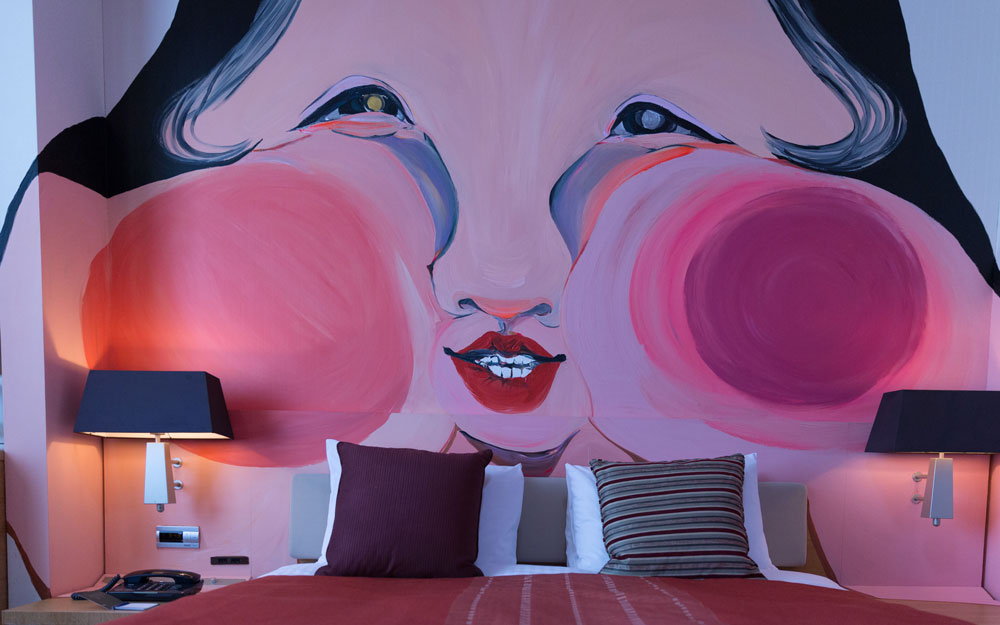
With this introduction, once we stepped inside the room, we were instantly drawn to the huge Otafuku face, which took up the entire wall overlooking the queen-sized bed. Its lush, cheerful colors clearly had influenced how the rest of the room was decorated, and its impact on the space was immense.
In order to realize Otafuku in the way she envisioned, Kondo spent nine days painting.
The room was large by Japanese standards, but still, the size of the painting was a bit overbearing. It begged the question: what kind of dreams might one have while resting beneath the influence of Otafuku?
"Is this room… popular?" Mami asked.
Matsubara nodded. "Yes! Because it not only offers this beautiful, happy painting, but also a wonderful view from the window." It was true. Otafuku had been so eye-catching, we had barely noticed the picturesque view of the city beyond.
There they were again: Tokyo Tower and Mt. Fuji, in all their iconic coolness. Matsubara said that with such a view, the rooms on this side of the hotel were more popular. She went on to explain that in order to realize Otafuku in the way she envisioned, Kondo spent nine days painting. Matsubara added that like other artists' work in the other rooms, the piece was a good example of the beauty of Japan, as well as its history.
To some, though, Otafuku probably isn't the epitome of female beauty. Her portrait was definitely a beautiful piece of art, but in some ways it also looked like a huge baby's face smushed up against a window.
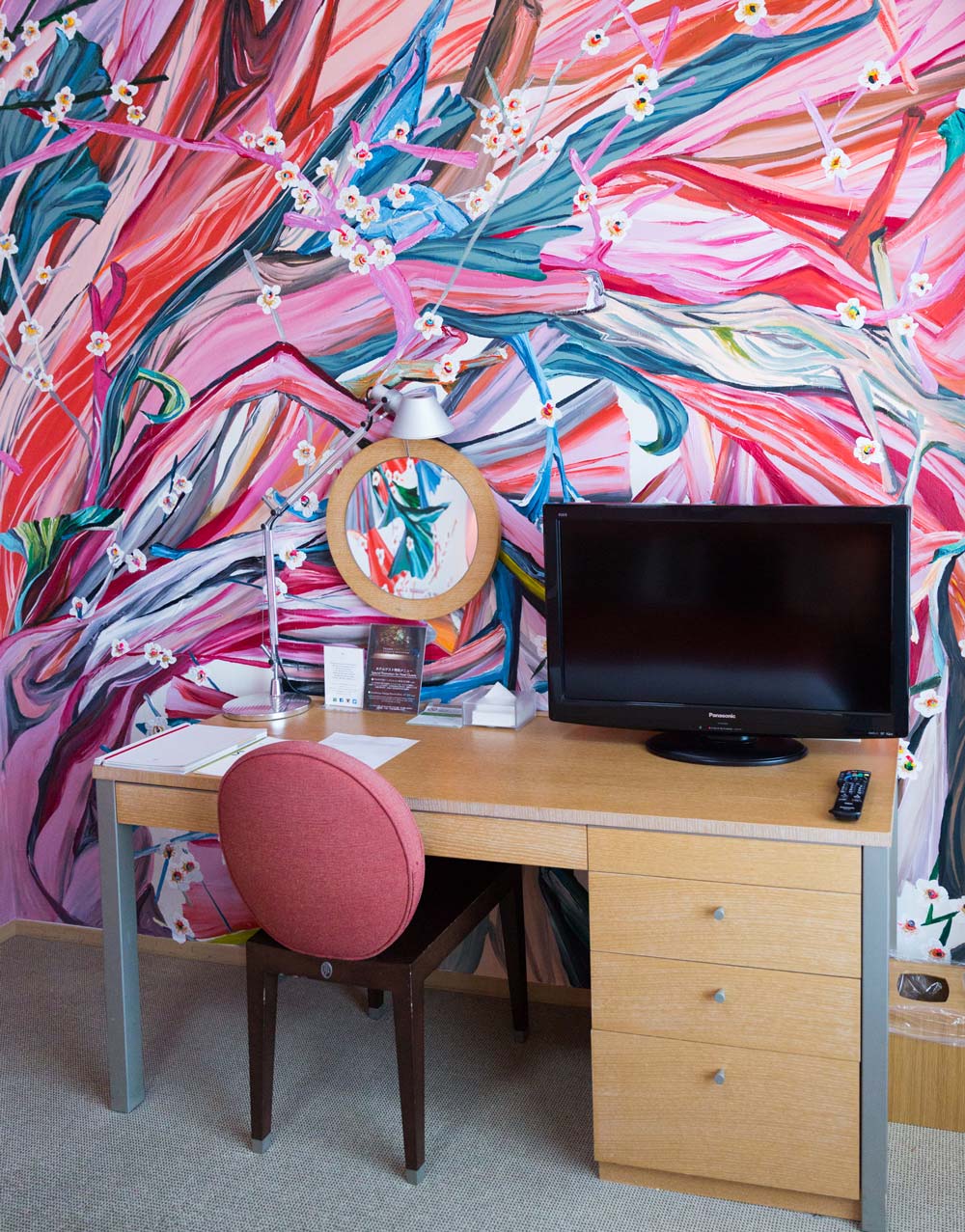
Before we left, we discovered the beautiful plum tree the artist had painted on one of the adjacent walls. Matsubara suggested we observe it up close—even touch it. "In a museum, you have to admire artwork from several feet away and only for a moment," she said. "Here, if you book the room, you can enjoy the art as long as you like."
She showed us how the artist had even painted some elements of Otafuku-san inside the closet! At this point, we felt like putting our feet up and spending more time here, but there were more rooms waiting for us.
Walking down the corridor, Matsubara told us the hotel has a list of rules that outline how those who are staying in these rooms should treat the artwork. Guests are aware of their value and seem to show respect. The artist rooms, she said, actually receive less damage than other rooms.
Our next stop was the Dragon room. In stark contrast to the colorful Otafuku room, this one was solemn and powerful. Painted by artist Abe Kiyoko (阿部清子) using calligraphy ink, a huge mythical Dragon curls its massive body all the way around the space, past the window with its view of Mt. Fuji, and finally comes face-to-face with a beautiful Japanese woman in kimono.

Matsubara allowed us to take in the feel of the room before she spoke. "Abe-san wanted guests to experience the contrast between the view from the window and the art in this room," she said. "Although modern Tokyo extends as far as you can see out that window, there are those who live in the raw world of nature. The dragon symbolizes that raw, natural energy, and the artist hopes that energy will lend itself to the room."
It seemed to work: the Dragon room was simple and felt more formal. We thought we could feel the presence of nature. We also learned that each of these rooms contains a small didactic panel that gives a description of the art—though we were lucky to have Matsubara, who gave us lots of extra information and cheerfully answered our questions.
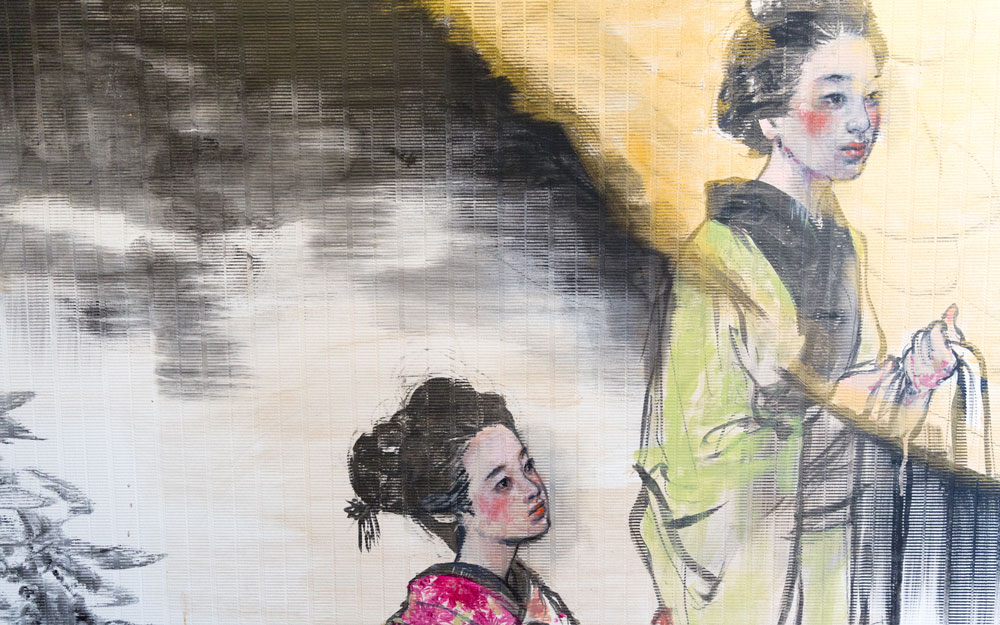
"How long did it take for this room to be completed?" Koichi asked.
"Ten days," answered Matsubara.
This surprised us. "Were all the rooms completed so quickly?" asked Mami.
"It depends on the artist. Some took much longer. Also, after a room is deemed finished, the artist can still come back to fix or touch up the odds and ends when the room is available."
"Is the art room project for a limited time only? Could the rooms be painted over and redecorated in the future?"
"No, no! They're permanent. Each of the thirty-one rooms are a precious asset to the hotel. We will keep them as long as we are able." Matsubara added that the hotel plans to add a gallery lounge and an art concierge as a floor guide—something they have already begun since the day we visited.
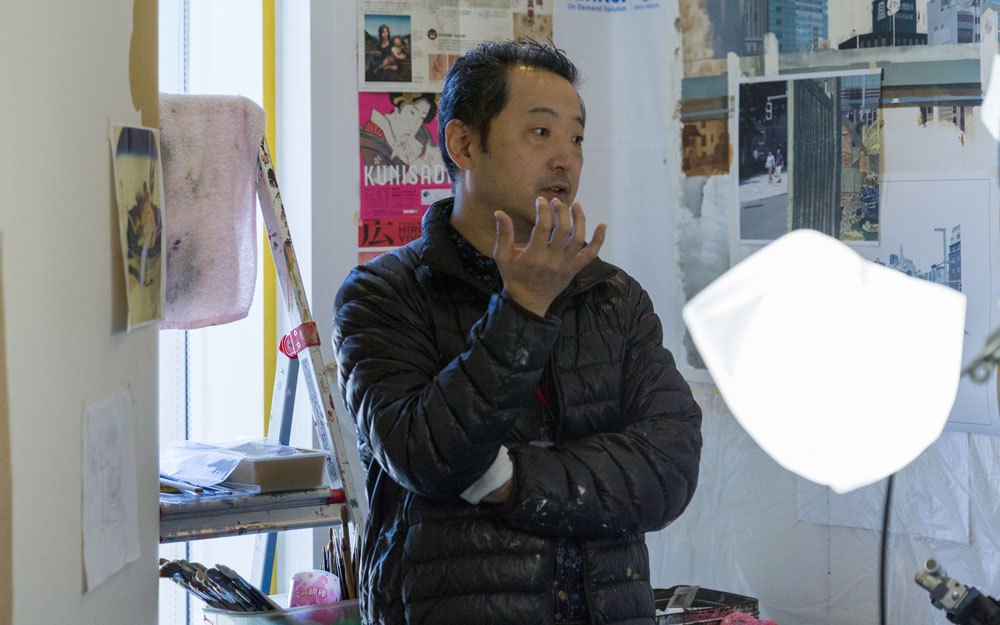
Next up was the Edo Tokyo room, where we were lucky enough to meet the artist, Furukawa Hidetaka (ふるかはひでたか). He had been working on it for more than two months, and it was obvious why. Incorporating several different components, his work was incredibly detailed, and much of it looked like a photograph. At first we thought one painting was of the view out the window, but as he explained, his version was an interesting blend of old and new Tokyo.

"I painted three Tokyo landmarks—Tokyo Tower, Tokyo Skytree, and Nihonbashi bridge," he said. "The same three locations were painted 160 years ago by Hiroshige, an Ukiyo-e artist, in his meisho-e. I'm making a current version of it." He said it was difficult to grasp the historical evolution of the city just by looking at it now, but combining it with older versions made it possible to experience both simultaneously.
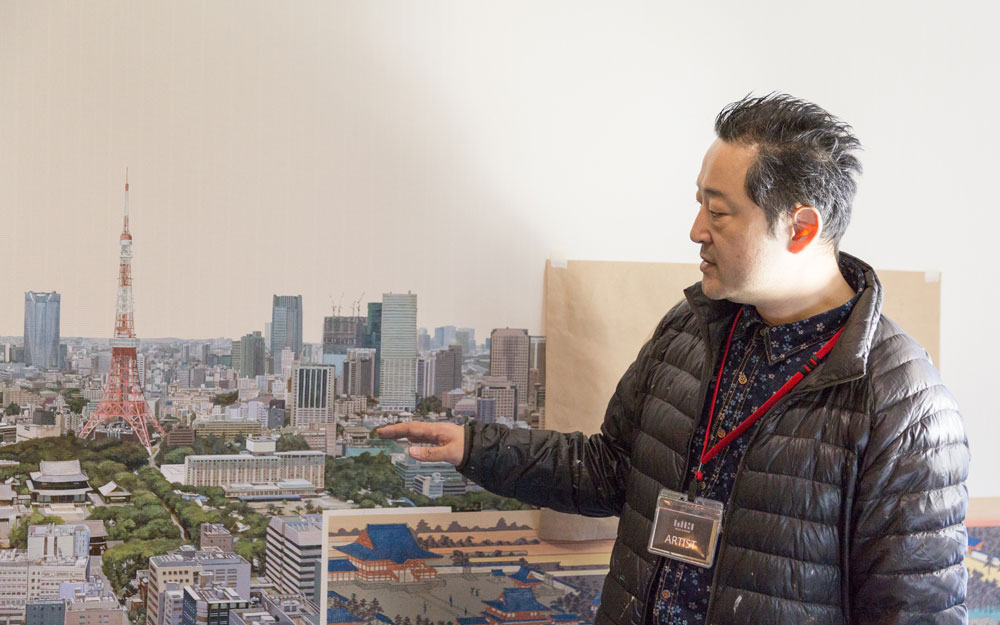
Another interesting piece was a map of the area during the Edo period some 200 years ago, which was covered by a scroll on which present-day Tokyo, based on a satellite photo, was traced. Combined, they conveyed a sense of history for the region, even as new structures like roads and buildings were built. Imagining how much work was involved in researching these details and painting the room made us respect Furukawa-san even more. It must have been time-consuming to make in this setting, but his work is sure to be appreciated by hundreds of people every year.

Our next stop was "Beauty of Akita," where a friendly artist, Otani Yuka (大谷 有花) and her manager opened the door to greet us. Neat and clean, the room was colorful in a quiet way, clad in Akita cedar, with a simple, elegant aesthetic of traditional Japan. Otani said that although she herself was not originally from Akita—she lives and teaches there now, at the Akita University of Art—she wanted to create a room where guests could discover the root of Japanese beauty.
"Tokyo is still in Japan, but it's very globalized," she explained. "I think traditional Japanese beauty remains in the smaller, local regions such as Akita. Since I started living there, I've come to know its history and scenery, as well as the lifestyle of the locals. I've become more aware of my own identity as a Japanese person." In creating a room full of Akita-themed depictions of traditional Japanese style, she was right—it made us want to visit Akita!

After bidding Otani goodbye, we went to Castle room, our last official stop, where the artist Mizuguchi Kazuki (水口 和紀) was reproducing an astonishingly detailed image of Edo Castle, which was originally built in Tokyo in 1457. In the room he had created an atmosphere so authentically Japanese, we felt as if we should take off our shoes before entering.
Mizuguchi explained that what he was doing was difficult because there is no actual Edo castle these days. He had to start from scratch, beginning with a plastic model based on existing photos and then painting the mural in excruciating detail. (We learned later it took him more than a year to finish the room!)
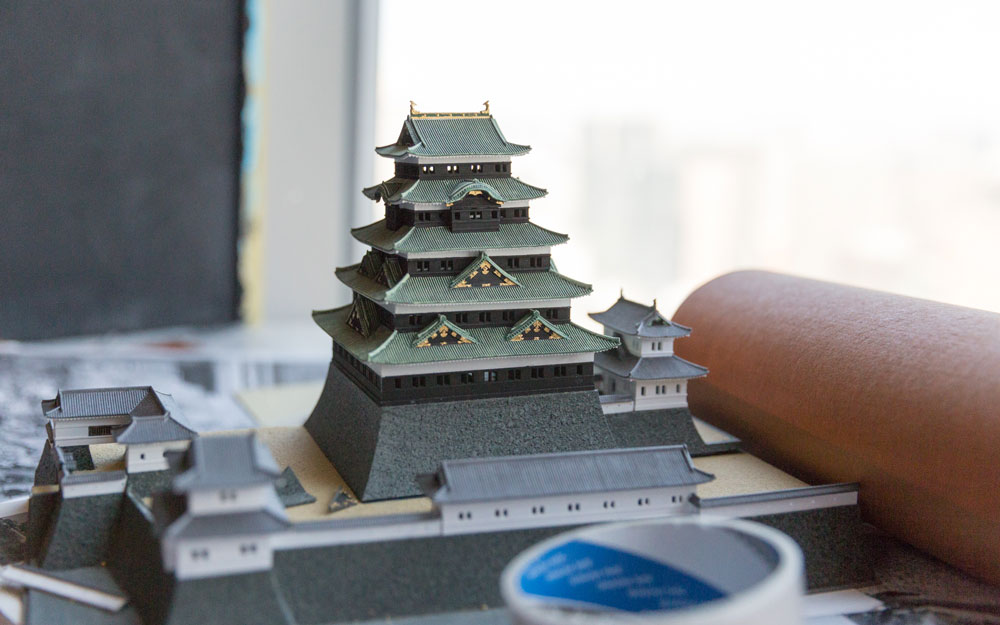
The results were impressive. That day, he was working on a part of the castle wall that reflected in the water of the surrounding moat. He had also created an optical illusion in the room. At night, when guests lay on the bed, the reflection of the castle painted on the wall behind them appears in the window. Next to that castle reflection: a reflection of Tokyo Tower bouncing off a nearby building. How cool is that?
At night, when guests lay on the bed, the reflection of the castle painted on the wall behind them appears in the window.
As our official tour came to an end, Matsubara repeated her earlier sentiment. "Each room is unique and has a different energy to it," she said. "The rooms are the hotel's precious assets. We will keep them this way as long as possible."
Everyone in our group agreed that staying in the rooms would be a wonderful experience, especially those with the incredible views. "Maybe it was good that you only checked out five rooms today," Matsubara said. "If you saw all of them, you'd want to stay in all thirty-one."
Mami asked, half-jokingly, "Why is it thirty-one rooms on the thirty-first floor? Is it related to Baskin-Robbins somehow?"
Matsubara laughed. "Sadly no. It just happened to be thirty-one rooms in total on this floor. There's no other meaning to it."
Finally, returning to the main floor, we saw two more gems: the temporary "Spring of Life" exhibition, which was fun to peruse and look for our favorites (we loved the cat-students, sculpted by Yuya Koiizuka, wearing gakuran!), and the Smoking Area, which smelled like cigarettes but was awesome as well, with walls filled with unique art by Hayashi Akihisa (林晃久), a.k.a. Marron-chan. Even the ashtray was adorable!
From top to the bottom, we thoroughly enjoyed our long and informative visit at Park Hotel Tokyo. Matsubara was lovely, as were all the other staff, and afterwards she even stepped outside to point out the best place for us to take a photo of the building. Even though the hotel is located in a quieter part of Tokyo, visitors are only a train-ride away from crazier spots like Shibuya, Shinjuku, Harajuku, Asakusa, Ueno, and Ginza.
The hotel is an ideal place to relax and spend time a unique, art-filled environment—thirty-one special spaces that are equal parts art gallery and comfortable hotel room. We highly recommend it!
Mami’s Review
All the artist rooms are masterpieces and the view from the windows was outstanding. I’m the type of person who doesn’t ask much from a hotel and usually I don’t care about the view and things like that. But this place was impressive. The staff was also very nice, so definitely thumbs up.
Viet’s Review
This is a nice hotel if you have the money. The main draw is the artist rooms, which I highly recommend staying in, if you can spring for the cost.
Koichi’s Review
As we saw the rooms and met some of the artists, what at first felt like a gimmick turned into something more. These rooms are treated as seriously as an exhibition in a museum, but they’re trusting guests to live inside them. I don’t think there are many hotels that can boast such a psychological effect for guests, making these art rooms a very unique opportunity.
Park Hotel Tokyo
Additional Information
1 Chome−7−7-1 汐留メディアタワー, Higashishinbashi
Minato-ku, Tokyo 105-7227
Japan
+81 3-6252-1111
